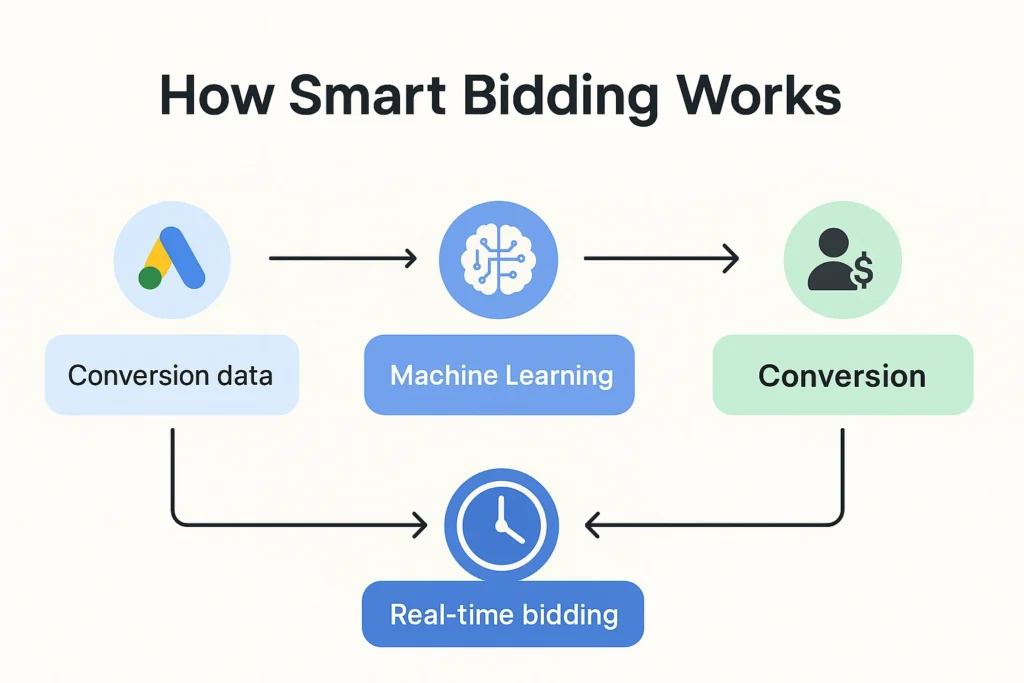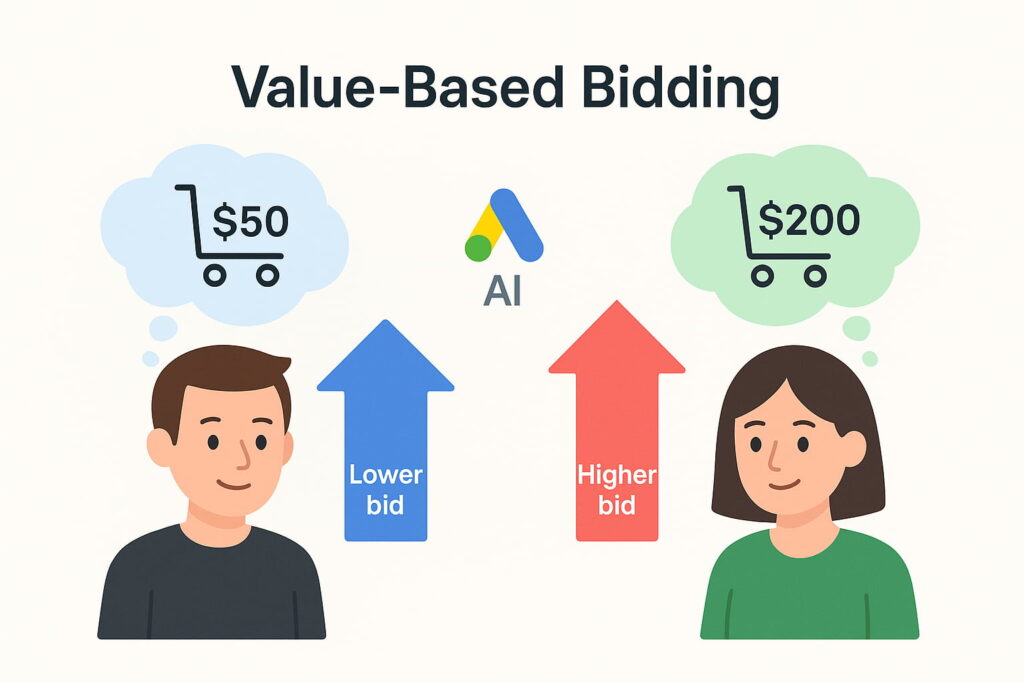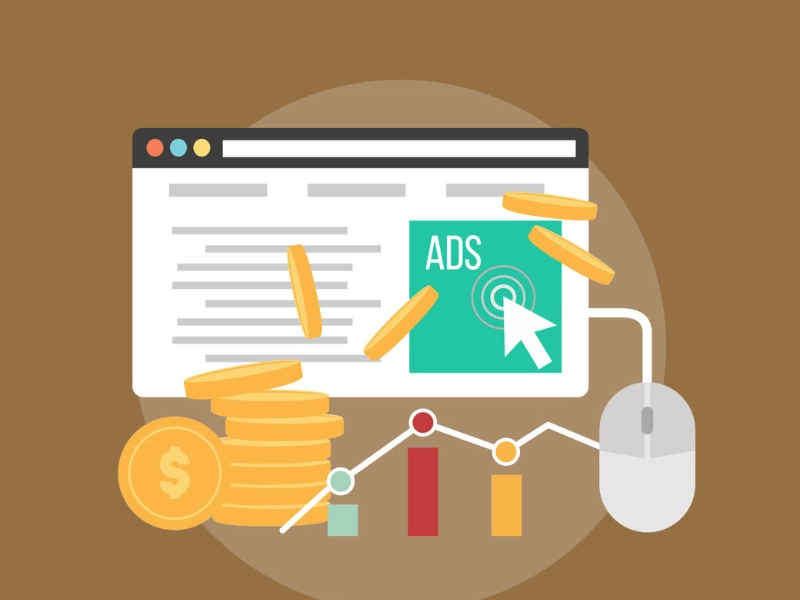Smart Bidding Strategies You’re Still Missing in 2025
The PPC is in a constant state of evolution, and in 2025, simply “using” Smart Bidding is no longer enough. Gone are the days of manual bid tweaks and one-size-fits-all tactics; today, campaigns focus on conversion optimization, AI-driven bidding automation, and data-driven decision making. Yet many advertisers still rely on outdated tricks and overlook advanced strategies. In this blog, you’ll discover next-gen Smart Bidding methods, performance-max strategies, and first-party data hacks for real ROI.
Understanding Core Smart Bidding Strategies
At its heart, Smart Bidding is a subset of Automated Bidding strategies within Google Ads, designed to optimize for conversions or conversion value.
Target CPA (Cost Per Acquisition): This strategy aims to get as many conversions as possible at or below the target cost-per-acquisition you set. It’s ideal when your primary goal is to acquire conversions within a specific cost threshold. The system uses historical Conversion Optimization data and real-time signals to predict the likelihood of a conversion and adjust bids accordingly.
Target ROAS (Return On Ad Spend): For businesses focused on revenue, Target ROAS is invaluable. It helps you get as much conversion value as possible at or below the target return on ad spend you set. This strategy is particularly effective for e-commerce businesses where different products have varying profit margins, allowing the system to prioritize higher-value conversions. It directly impacts your Return on Ad Spend (ROAS) by focusing on the value of each conversion.
Maximize Conversions: As its name suggests, this strategy aims to get the most conversions possible within your budget. It’s a straightforward approach for advertisers whose primary goal is to drive conversion volume, regardless of the individual cost per conversion, as long as it stays within the daily budget. This strategy is often a good starting point for new campaigns or when you have a clear conversion action you want to maximize.
Maximize Conversion Value: Similar to Maximize Conversions, but with a crucial distinction: it focuses on maximizing the total value of your conversions within your budget. This is particularly useful when conversions have different values, allowing the system to bid more aggressively on those likely to generate higher revenue. This directly contributes to maximizing your overall Conversion Value.

Overlooked Advanced Smart Bidding Tactics for 2025
These advanced approaches allow for a deeper level of optimization, pushing beyond mere automation to truly intelligent campaign management.
Leveraging Performance Max
This campaign type, powered by Google’s AI, is designed to find converting customers across all of Google’s channels – YouTube, Display, Search, Discover, Gmail, and Maps from a single campaign. It’s about providing the system with high-quality assets (images, videos, headlines, descriptions) and clear conversion goals, then trusting the AI to find the best opportunities across the entire Google ecosystem. The real power lies in its ability to optimize for cross-channel bidding, ensuring that your budget is allocated to the channels and ad formats that are most likely to drive conversions at the most efficient Cost Per Acquisition (CPA).
Refining Audience Signals
This includes customer match lists, remarketing audiences, and custom segments based on website behavior. The more information you provide about your ideal customer, the better Google’s AI can identify and target similar high-value users.
Advanced audience segmentation involves creating granular segments based on purchase history, engagement levels, and even predicted future behavior. By feeding these refined audience signals into your Smart Bidding strategies, you empower the system to make more informed decisions, leading to more precise bid adjustments and improved ad relevance.
Value-Based Bidding
Value-Based Bidding strategies like “Maximize Conversion Value” and “Target ROAS” allow you to tell Google’s AI what a conversion is truly worth to your business. This is no longer just for e-commerce with varying product prices.
- For E-commerce: This is non-negotiable. You should be passing dynamic transaction values back to Google Ads.
- For Lead Generation: Assign values based on lead quality. A “request a demo” lead is far more valuable than a “download a whitepaper” lead. You can assign static values in Google Ads or dynamically pass them from your CRM.
- Customer Lifetime Value (CLV): The most advanced approach is to bid based on predicted CLV. By integrating your customer data, you can tell Google to bid more aggressively for users who share characteristics with your most loyal and high-spending customers.
If you haven’t already, your top priority should be setting up accurate conversion value tracking. Without it, you can’t effectively leverage the most powerful aspect of modern Smart Bidding.

Optimizing for Profitability, Not Just Volume
Effective smart bidding means striking a delicate balance between ad spend efficiency and achieving your desired Return on Ad Spend (ROAS) and Cost Per Acquisition (CPA). This requires a deep understanding of your profit margins and customer lifetime value, allowing you to set realistic and profitable targets for your automated strategies. If your CPA is too high, even with a high conversion volume, your campaigns may not be sustainable.
Manual Control within Automation
Despite the rise of automation, there are still scenarios where a degree of manual control within your Smart Bidding strategy can be beneficial. Enhanced CPC, for instance, allows Google to automatically adjust your manual bids up or down to help you get more conversions, while still giving you control over your base bids. For instance, during promotional periods or when launching new products, temporary manual bid adjustments or a shift to Enhanced CPC might be necessary to ensure aggressive visibility.
Real-World Case Studies and Performance Metrics
Case Study 1: E-commerce Smart Bidding Transformation
An online retail brand implemented Smart Bidding Exploration and achieved remarkable results:
- 50% conversion increase within three months
- 20% cost per conversion reduction
- 35% expansion in profitable search categories
The strategy involved transitioning from manual bidding to automated strategies with broad match keywords and flexible ROAS targets.
Case Study 2: B2B Lead Generation Optimization
A B2B technology company leveraged Target CPA portfolio strategies:
- 45% improvement in conversion rates
- 30% reduction in cost per acquisition
- Enhanced lead quality through value-based optimization
The implementation focused on competitive analysis and buyer journey-specific ad copy optimization.
Case Study 3: Pharmaceutical Bidding Revolution
Vamstar’s AI-powered Pricing Co-Pilot helped a top-10 pharmaceutical company optimize tender bidding:
- $1.5M in additional revenue
- 76% increase in tender win rates
- 32% margin growth through predictive bidding insights
Advanced Bid Adjustments and Modifiers
Strategic bid adjustments remain crucial for maximizing Smart Bidding performance. The latest approaches go beyond basic device and location modifiers to incorporate sophisticated targeting matrices.
Device-Specific Optimization
Modern device bidding strategies recognize that user behavior varies significantly across platforms:
| Device Type | Typical Performance | Recommended Adjustment |
| Mobile | Higher CTR, lower conversion rate | -20% to +30% |
| Desktop | Lower CTR, higher conversion rate | +10% to +50% |
| Tablet | Moderate performance across metrics | -10% to +20% |
Geo-Temporal Targeting Matrix
Advanced practitioners implement location and time-based adjustments simultaneously, creating highly targeted campaign segments. This approach recognizes that the same location can represent different audience compositions and intent signals depending on the time of day.
Performance Impact
Strategic bid adjustments deliver measurable results:
- Mobile optimization: 15% CTR increase
- Desktop targeting: 25% conversion rate boost
- Location-based adjustments: 35% revenue increase
- Time-based bidding: 20% efficiency gains[Derived from analysis]
Seasonality and Event-Driven Bidding
Seasonality adjustments represent a sophisticated approach to managing temporary conversion rate fluctuations. Unlike traditional bid modifications, these adjustments specifically inform Smart Bidding algorithms of expected changes, enabling proactive optimization.
Use Case Scenarios
Seasonality adjustments excel in specific situations:
- Flash sales: 30-50% expected conversion rate spikes during limited-time promotions
- Holiday periods: Anticipated changes in user behavior and purchase intent
- Business closures: Temporary reductions when unable to handle inquiries
- Product launches: Initial period optimization for new offerings.
Technical Implementation
Seasonality adjustments work by temporarily modifying conversion rate expectations within Smart Bidding strategies. The system instantly reverts to pre-event behavior after the adjustment period, eliminating learning phases and maintaining long-term optimization integrity.
Cross-Device and Attribution Modeling
Cross-device conversion tracking has become essential as consumer journeys increasingly span multiple devices. Research indicates that nearly 40% of online shoppers start research on smartphones and complete purchases on computers or tablets.
Attribution Model Integration
Modern Smart Bidding incorporates sophisticated attribution models that:
- Track conversions across devices and browsers
- Utilize privacy-safe modeling for complete journey visibility
- Enable auction-time bidding decisions based on full conversion paths.
Implementation Benefits
Businesses implementing comprehensive cross-device tracking with Smart Bidding see:
- More accurate conversion attribution
- Improved mobile bid optimization
- Enhanced campaign performance measurement
- Better budget allocation across devices.
Enhanced Conversions and First-Party Data
The integration of first-party data through Enhanced Conversions has become a critical Smart Bidding enhancement. Organizations utilizing first-party data for marketing decisions experience a 2.9x revenue uplift and 1.5x cost efficiency improvement compared to third-party data reliance.
Data Integration Strategies
Successful first-party data integration involves:
- Google Ads Data Manager: Connect CRM and customer data platforms
- Enhanced Conversions for Web: Supplement existing conversion tags
- Enhanced Conversions for Leads: Share offline conversion data
- Frequent data uploads: Daily conversion tracking for optimal performance.
Common Pitfalls and How to Avoid Them
1. Insufficient Data for Learning Phases
Every Smart Bidding strategy goes through a learning phase, during which it gathers the data it needs to optimize bids. This phase can last for several days or even weeks, depending on the volume of conversions. If you make frequent changes to your campaigns during this period, or if your campaigns generate very few conversions, the learning phase can be prolonged, and the algorithm may never reach its full potential.
To avoid this, ensure your campaigns have a sufficient budget to generate a reasonable number of conversions (Google recommends at least 30 conversions in the last 30 days for Target CPA and at least 50 for Target ROAS).
Be patient during the learning phase and avoid making significant changes to your campaigns, such as altering your budget, changing your ad copy, or adjusting your conversion actions. Providing a stable environment for the algorithm to learn is essential for long-term success.
2. The Critical Role of First-Party Data
With the ongoing depreciation of third-party cookies, the quality of the data you provide to Google’s AI is more important than ever. Relying solely on Google’s audience signals is no longer sufficient for a competitive edge.
Your Smart Bidding is making decisions based on a limited and increasingly less reliable dataset, leading to less accurate targeting and wasted ad spend. Your customer data is your most valuable asset. In 2025, successfully using PPC automation means enriching it with your insights.
- Customer Match: Regularly upload your customer lists (emails, phone numbers). This allows you to re-engage existing customers, find new customers who look like your best ones (lookalike audiences), and exclude existing customers from acquisition campaigns.
- Enhanced Conversions: This feature securely sends hashed first-party conversion data from your website to Google. It helps to fill in the gaps left by cookies and improves the accuracy of your conversion measurement, giving Smart Bidding better data to work with.
- Offline Conversion Tracking:
If you close leads offline (e.g., over the phone or in person), you
must be importing this data back into Google Ads. Otherwise, Smart Bidding is only seeing a fraction of the customer journey and can’t optimize for your most valuable final outcomes.
Conduct an audit of your first-party data sources. Create a plan to regularly and automatically upload this data into Google Ads to give your Smart Bidding campaigns the fuel they need to perform optimally.
3. Portfolio Bidding and Seasonality Adjustments
If you’re still managing bids on a campaign-by-campaign basis, you’re missing out on broader optimization opportunities.
Your individual campaign goals may be conflicting, or you’re not proactively preparing the algorithm for predictable market changes.
| Strategy | Best Use Case | Performance Impact |
| Target CPA Portfolio | Lead generation across multiple campaigns | 15% average conversion increase |
| Target ROAS Portfolio | E-commerce campaigns with varying product margins | 12% revenue optimization |
| Maximize Conversions Portfolio | Brand awareness and volume-focused campaigns | 25% conversion volume boost |
Proactive Bid Management
- Use Portfolio Bidding Strategies:
Group campaigns with similar goals into a portfolio bid strategy. This allows Google’s AI to allocate your budget across these campaigns to achieve a collective CPA, ROAS, or impression share target. It’s a more efficient way to manage bids at scale and can improve overall performance.
- Use Portfolio Bidding Strategies:
- Leverage Seasonality Adjustments:
For predictable events like holidays, sales, or industry conferences, use seasonality adjustments. This tool allows you to inform Smart Bidding of an expected short-term change in conversion rates. This helps the algorithm adjust its bidding more quickly and aggressively during these critical periods, and then return to normal without a lengthy re-learning phase.
- Leverage Seasonality Adjustments:
Identify campaigns with shared goals and test grouping them into a portfolio strategy. Map out your key business seasons for the year and schedule seasonality adjustments in advance.
Performance Monitoring and Optimization
Key Performance Indicators
Modern Smart Bidding success requires monitoring beyond traditional metrics:
| Metric Category | Primary KPIs | Optimization Frequency |
| Conversion Performance | CVR, CPA, ROAS | Daily |
| Query Expansion | Unique query categories, Search term growth | Weekly |
| Device Performance | Cross-device attribution, Device-specific CVR | Bi-weekly |
| Value Optimization | CLV, Profit margins, Revenue per conversion | Monthly |
Limitations of Smart Bidding
1. Limited Transparency (“Black Box” Problem)
Smart Bidding relies heavily on Google’s machine learning algorithms, but it doesn’t reveal how
it makes bid decisions. Advertisers have little visibility into which signals are being prioritized (e.g., device, time, user intent) or why certain changes happen. This can make troubleshooting difficult.
2. Requires Sufficient Conversion Data
Smart Bidding strategies like Target CPA and Target ROAS need historical conversion data to perform well. Without at least 30 conversions (Target CPA) or 50 conversions (Target ROAS) in the past 30 days, the algorithm may underperform or stay in a prolonged learning phase.
3. Slower Reaction to Sudden Changes
Because Smart Bidding algorithms learn based on trends and patterns, they may not react fast enough to:
- Flash sales or limited-time offers
- Sudden product launches
- Unexpected market shifts (e.g., viral content, bad press)
This is where seasonality adjustments or manual overrides may be necessary.
4. Overdependence on Google Signals
Google’s AI pulls signals from user behavior, but those can become less accurate due to:
- Privacy restrictions (GDPR, cookie deprecation)
- Limited third-party tracking
- Incomplete or unshared first-party data
This means poor bidding decisions if your audience data isn’t enriched with Customer Match or Enhanced Conversions.
5. Limited Custom Control
Once Smart Bidding is enabled, manual bid adjustments and controls like device/location modifiers are restricted or ignored. You can’t easily override its choices without switching strategies, which can disrupt performance if not done carefully.
Future Trends and Predictions
AI Integration Expansion
Expect deeper AI integration across all bidding strategies, with increased use of predictive analytics and real-time market adaptation. The trend toward autonomous campaign management will accelerate, requiring marketers to focus more on strategy and less on tactical execution.
Privacy-First Optimization
As privacy regulations evolve, first-party data utilization will become even more critical. Smart Bidding strategies will increasingly rely on enhanced conversions and privacy-safe modeling techniques.
Cross-Platform Integration
Future developments will likely include better integration across Google’s advertising ecosystem, enabling unified bidding strategies across Search, Display, YouTube, and Shopping campaigns.
Conclusion
What works today might not be optimal tomorrow, and new opportunities can emerge with platform changes. This means staying informed about the latest developments from Google, whether through official blogs, industry publications, or PPC communities. Regularly review your campaign performance, analyze the impact of any recent Google Ads updates, and be prepared to adapt your strategies accordingly.If you want expert help implementing these strategies, our team lives by the motto “We Do This Best.”
We’ve helped numerous clients transition to next-level bidding tactics, and we’re ready to do the same for you.Reach out today or explore our PPC solutions to see how our smart bidding expertise can boost your ROI.
FAQ
1. What are two types of value-based smart bidding strategies?
The two types of value-based Smart Bidding strategies are Target ROAS (Return on Ad Spend) and Maximize Conversion Value.
2. What is Smart Bidding in Google Ads?
Smart Bidding is an automated bid strategy that uses machine learning to optimize for conversions or conversion value in each auction.
3. How does Target ROAS differ from Target CPA?
Target ROAS focuses on maximizing conversion value based on your return on ad spend goal, while Target CPA aims to get as many conversions as possible at a specific cost per action.
4. When should I use Maximize Conversion Value?
Use Maximize Conversion Value when you want Google to automatically prioritize higher-value conversions within your daily budget.
5. Is Smart Bidding suitable for all campaigns?
Smart Bidding works best for campaigns with sufficient conversion data, but it’s not ideal for brand-new accounts or those with low historical performance data.





